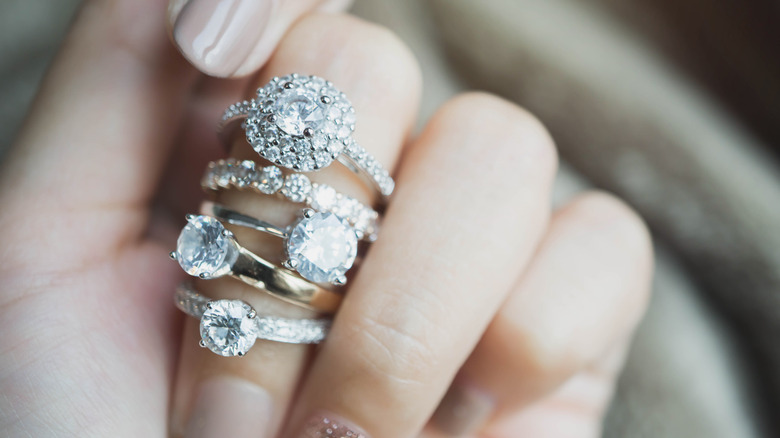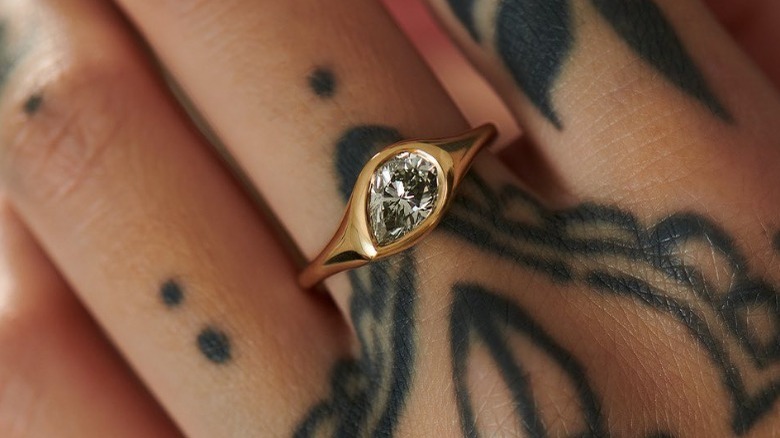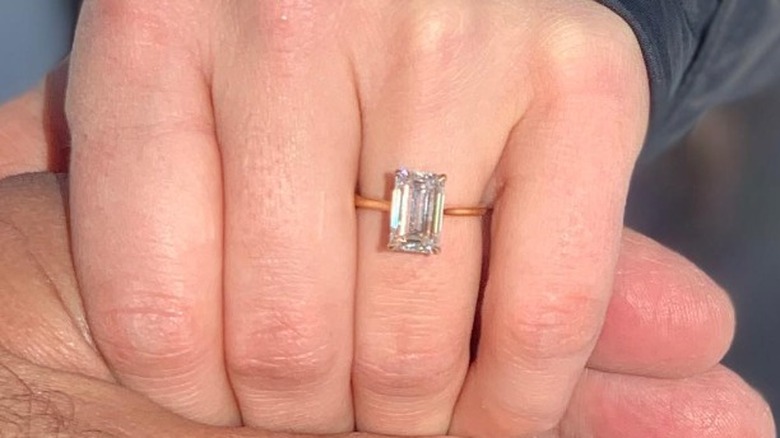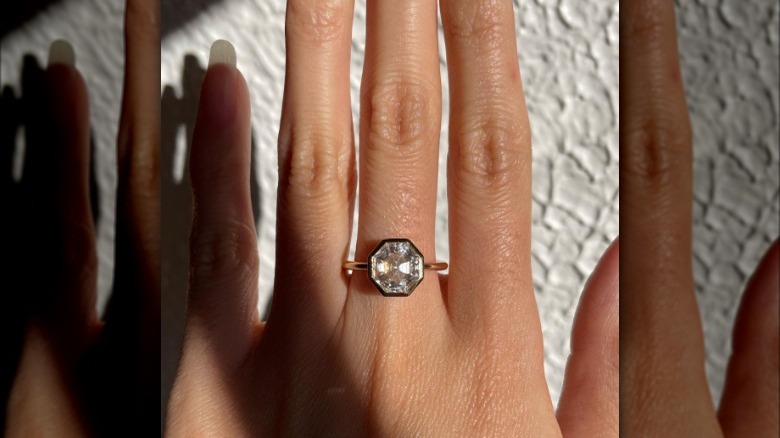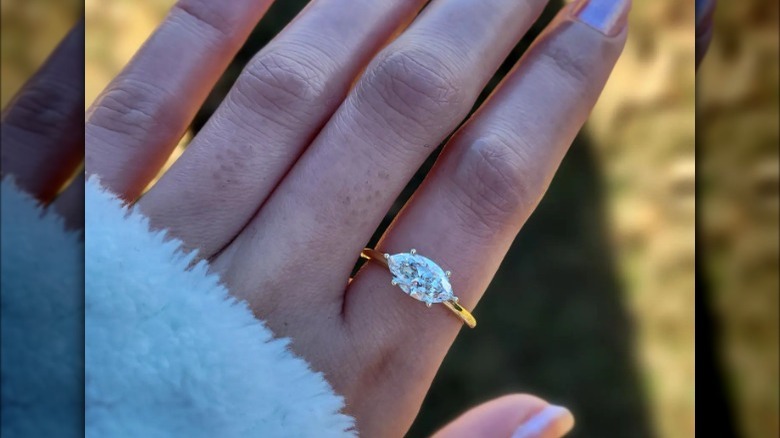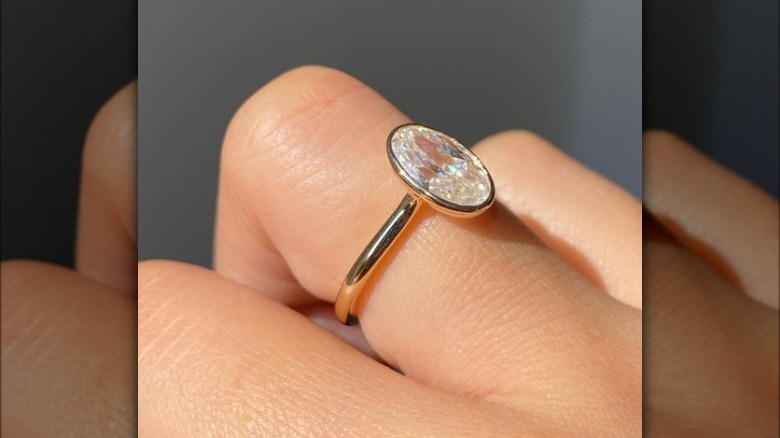Bezel Vs. Prong Setting: The Engagement Ring Terms Explained
Looking at engagement rings can be an overwhelming experience. There are plenty of styles available and even more that are trending, so it can be hard to narrow down exactly what you like. Plus, some terms are always thrown around that can start to overlap and make the search even more confusing. After all, selecting an engagement ring is no task to take lightly.
This is one piece of jewelry you or your partner will wear for years. Of course, you want a ring style you'll love to look at for the next few decades. But since it's also a piece of jewelry you'll wear daily, there are other factors to consider that relate to the ring's integrity. Two of the most common settings for engagement rings are bezel and prong. And though they may both be among the most popular settings, they couldn't be more different. Before you go ring shopping, here's what you have to know about bezel and prong settings.
What's a bezel setting?
Let's start with definitions. A bezel setting has a metal ring that goes around and encases the edges of the stone to help keep it in place. "The bezel setting has probably been used since the beginning of jewelry design and stone setting," jewelry designer Emma Clarkson Webb says in an interview with Brides. The setting is old and characteristic of many antique rings but has also been growing in popularity for modern-made rings. So if you're looking for a ring style that has a vintage flare, bezel settings are a ring style to consider.
Bezel settings work best for stones in round, brilliant, or rose cuts because they allow for a low-set profile. However, that's not to say you can't get a bezel setting with other shapes or cuts. Many people also love how bezel settings look because the stone can appear larger, and its "settings create a trick of the eye to enhance the size of the stone," Webb says. "They create an illusion that the stone is larger than it actually is, particularly when the color of the metal is matched to the shade of the stone." And if you like the look of multiple stones, bezel settings can be combined with other settings to create multi-stone designs. However, one thing to note is that bezel stones can be more expensive than other settings because they require more metal and labor to create.
What's a prong setting?
Of all the setting styles for engagement rings, prong settings are the most common. Prongs are thin strips of metal that hold the stone in place. These strips create a cradle that extends from the ring band. The stone is inserted into the cradle, and the tips are bent to secure the stone in place. While prong settings are considered the most popular, they're relatively new in jewelry making. The style debuted in 1886 by Tiffany & Co. Though the style is over a century old, prong settings look sleek and modern and have become a timeless option for engagement rings.
Prong settings are loved because the minimal detailing shows off more of the stone, and more light can hit the jewel, allowing for maximum sparkle. This setting style is also highly customizable, allowing you to have a variety of shapes and cuts. Rings are typically available with four and six prongs. Four prongs obstruct the stone less but can be less secure, whereas the opposite is true for six prongs: more secure but covers the gem more. Prong settings are also easily combined with other settings, so a multi-stone engagement ring is possible.
Delicate vs. thick
Aesthetic is a top factor when choosing an engagement ring, and bezel and prong settings couldn't look more different. Bezel settings provide an overall thicker look to engagement rings because of the extra metal around the stone. Depending on the ring style, the band can also be thicker, resulting in a bulkier look. Bezel settings also tend to have a more antique look, especially with full bezel settings. But there are partial bezel settings with gaps or openings in the metal bezel, which can look more updated.
In general, rings that have prong settings are a lot more delicate and dainty in appearance. Because of the minimalist design, prong settings look sleeker and more modern, so they're ideal for those who prefer a contemporary look. Prong settings also tend to be more creative with stone shapes and combinations, making great non-traditional engagement rings. However, you should be cautious about going too dainty with the engagement ring band. The standard for a band is 3 mm to 4 mm. Ultra-thin bands — those under 3 mm — might not be able to support a stone that's more than a carat.
Protection comes into play
Since an engagement ring will be worn daily for years, durability and protection should be a top priority. When it comes to protecting that center stone, bezel settings are no doubt better. The metal encasing the sides of the stone keeps it in place, and the risk of the stone falling out or the setting loosening is much lower. Unfortunately, a greater chance of losing a gem with a prong setting exists. The thin metal prongs can bend or become misshapen, leaving the stone vulnerable to falling out of the setting. The good news is that this doesn't happen randomly. You'll have to hit the ring or catch a prong on something to do enough damage to loosen the setting.
If you have a profession that requires extensive hand use, are very active, or are on the clumsier side, bezel settings might be the better option. The extra protection around the sides can help prevent damage to the stone. If you're active or use your hands a lot and are set on a prong setting, removing your ring to protect the stone is the best option.
Protection when creating the ring is also a factor. Because bezel setting requires hammering the metal to encase the stone, many jewelry designers shy away from colored gemstones and heirloom gems. Breaking or chipping from the hammer is risky, so placing them in a prong setting is best.
Keep cleaning in mind
Engagement rings can quickly become gunky with daily wear, so they'll need regular cleanings to maintain their sparkle. With both prong and bezel settings, dirt and grime can be between the tiny spaces. Prong settings are usually raised and have space between the metal strips, which can trap dirt after being worn daily. And the tiny crevice where the metal ring meets the stone can also capture dirt.
Luckily, both settings can easily be cleaned at home with gentle dish soap. Make a solution of warm water and dish soap and allow the ring to soak for 20 to 40 minutes before brushing the ring with a toothbrush to remove dirt or grime. Then run it under warm water to rinse away the soap. Use a soft cloth — not a paper towel — to dry off the ring or allow it to air dry. Cleaning about once a week removes dirt, oil, and buildup. But to have your ring sparkle, you'll want to take it to be professionally cleaned once or twice a year. Professional cleaners are especially adept at primping out those little crevices that collect dirt.
